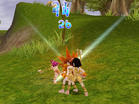股票期货突破技术分析(英文原版)-第15部分
按键盘上方向键 ← 或 → 可快速上下翻页,按键盘上的 Enter 键可回到本书目录页,按键盘上方向键 ↑ 可回到本页顶部!
————未阅读完?加入书签已便下次继续阅读!
The morning star; or morning cross; is。the inverse of the evening star; or evening cross。 If the star candlestick。represents。a new low; it's。highly likely。that a bottom has。been reached。 However; a star; or cross; does。not necessarily indicate a bottom。 Confirmation of a bottom es。only with the pletion of the three rivers。pattern (see Figure 4。35)。
Three Soldiers
Three soldiers。occurs。when there are three white or black。candlesticks。all moving in the same direction。 Three white soldiers。is。a pattern of three white candlesticks。that do not open higher but consistently close higher。 It’snsidered a precursor to a major uptrend。 The inverse; in which three consecutive black。candlesticks。produce declining highs; is。called three black。soldiers。(also three black。crows) and predicts。a significant decline。 The Japanese have traditionally considered the crow to be an unlucky bird; and the black。of the candlesticks; corresponding to the black。of the crows; is considered bad luck。for the markets; the beginning of a decline。
On the other hand; three white soldiers。appearing in an uptrend signals。resistance to higher prices。 If the white candlesticks。bee progressively smaller; the soldiers。are 〃at a dead end〃 and the market is。likely to peak。
Three Black Crows
Three black。crows。is。a classic。indication that a bear market has begun。 This。pattern occurs。in an uptrend when there are three consecutive and contiguous。(no gaps) black。candlesticks。 It'snsidered to signal the start of a prolonged bear market; but must occur at a relatively。high point for the pattern to hold。 Note also that if the first black。candlestick。gaps。upward; it is。an osaekomi pattern and a buy signal (see Figure 4。36)。
Three White Soldiers
This。pattern is the inverse of three black。crows; or three black。soldiers。 It monly。occurs。when prices。have been sliding downward and the market is。searching for a bottom。 The three consecutive white candlesticks。are relatively small; but indicate that the market is。on better footing and has。bottomed out。 The bottom isnfirmed only if prices。do not fall below the first white candlestick。(see Figure 4。37)。
Three Gaps
As。the name implies; three gaps is。a series。of three consecutive gaps。 Market wisdom says。that in an uptrend you should *4sell into three jumps。up;n whereas。in a downtrend; you should 〃buy on three poundings〃 because this。often signals。a major trough。 Pounding refers。to a selling climax after the third gap downward; because the bears。have sold all they have to sell。
When there is。no overlap between the first days。and the second day's。candlesticks; the gap between the two is。referred to as。a window。 If a trend is。breaking out of a holding pattern (moving significantly in either direction after a period of narrow moves); market wisdom says。to follow the break。 It's。generally easier for the market to move in the direction of the break。 The holding pattern will often close the window (actively trade at the gap); and it ismon for prices to return to their original levels。 This。isnsidered a turning point in the market。 The occurrence of three of these turning point gaps in a row is considered extremely significant (see Figure 4。38)。
Three Methods
The legends。of Munehisa Homma (and there are many) say that he had a third method he emphasized in addition to selling and buying: resting。 If the market is。trading in a narrow range; frequent buying and selling is。unlikely to increase earnings。 The more often you trade; the higher your costs。(in the form of trading missions) and the more likely you will take a loss。 It's。important at these times to rest—and knowing when to time your rests。is。just as。important as knowing when to time your buying and selling。
The three methods。pattern shown in Figure 4。39 is。the candlestickbination that tells。you to rest。 Three methods is。also referred to as three rules。and refers。to the three choices。of selling; buying; or resting。
In the top pattern of Figure 4。39; an uptrend has。produced a large white candlestick。followed by harami patterns。(either white or black)。 There is。then the large white marubozu that exceeds。the previous。high to form a classic。breakout from a holding pattern。 The small harami patterns。indicate a break。in the action。 The bottom of the large white candlestick。has。bee a support line and the top a resistance line。 Having broken through the resistance line; the pattern appears。very bullish; but the important thing according to the three methods。is。to forgo either buying or selling until the price breaks。out。 The same is true of the inverse pattern。 The bottom pattern in Figure 4。39 occurs。in a downtrend and appears。to be bearish; but you refrain from trading until the downward break。
Over a century has。passed since candlesticks。took。their present form。 The fact that traders。still use techniques。that were pioneered in the Dojima rice markets is。a testament to their value in illustrating the dynamic。movements。of price。 While many technical indicators。have been developed to measure trends; gauge momentum; and identify price targets; candlesticks。serve as。the foundation to which other techniques。are applied。 With a solid understanding of candle patterns; you will find that you are able to use conventional indicators。with more precision and confidence。 From Munehisa Homma's。handmade candle charts。to the sophisticated charting software we now enjoy; candlesticksntinue to jump off the screen and let traders。truly feel the rhythm of the markets。
CHAPTER。5
Price and Time
CONSTANCE BROWN
Price projection accuracy is。possible when the concept of confluence is clearly。understood。 Confluence is。a precise target zone derived from multiple price projections utilizing the natural expansion and contraction of price movement found in all markets。and time horizons。 The results。form a mathematical grid that allows。precise entry and exit strategies。prior to any trade; with measurable risk…reward ratios。 The concept of price confluence is。then developed further to study confluence targets。on the diagonal and vertical axes。to determine time projections。as。developed by W。D; Gann。 Gann accurately。timed the start; magnitude; and duration of the crash of 1929。
Oil will be key to global equity indexes。into the year 2012。 These global equity indexes。are being set up right now; allowing us。to use the current market data in November 2006 to consider the implications。before us。
Fibonacci Price Targets
To determine support or resistance price levels; many favor the use of Fibonacci retracements。 But this method of subdividing a range is。not used to its。full potential。 Basic。applications。simply define a market swing and subdivide the range between a selected price high and a price low into the ratios。0。618; 0。50; and 0。382。 Unfortunately; this。method overlooks。the fact that markets。have a natural expansion and contraction cycle。 To traders; this。means。their Fibonacci targets。will work。in markets。producing equality。swings。only; however; they will fail when the market is。expanding or contracting relative to the range first selected。
When a contraction cycle influences。a rally or a decline; the Fibonacci targets。derived from a major price high and low will be exceeded。 In a contracting cycle; traders。are stopped out by entering the market too early; only to see the market reverse and take off without them。 In an expansion cycle; the trader's。entry level is。never achieved。 The market reverses; forcing a chase that increases。the capital risk。and pels。the trader to establish a smaller position as。the opportunity slips。away。 For this。reason many abandon the use of Fibonacci ratios; they feel they work。only some of the time。 In essence; they are right。 But Fibonacci retracements。are not the problem; it's。their application that needs。to be changed。
Figure 5。1 displays。the current monthly continuous。futuresntract for crude oil。 The monthly chart shows。the recent market decline into November of 2006 and raises。the first question: how far will this。decline carry the market? Although sharp; this。is。a correction only。if the scenario into 2012 isrrect。 This。is。the important pullback。for the long…term horizon; therefore; we need precise targets。to monitor。 This can be done using multiple Fibonacci retracements。
When defining support for a correction in a rallying market; always start at the top and only。then select a low。 The first point selected should be zero。 The first calculation within the range below zero should be a value of 38。2 percent; followed by 50 percent and 61。8 percent。 The price low selected at the bottom of the range is。100 percent。 Bloomberg does。these calculations correctly; but TradeStation defines the first point selected as 100 and reverses。the order。 Recognizing a 38。2 percent and 61。8 percent ratio will fall on the same price levels。within the range; it bees。understandable why different quote vendors。have different opinions。about how this。should be programmed。 However; most vendors。force the user to remain generic and take away the user's。ability to use the geometric。proportions。that develop within the market's。data swings。 Study the charts。in this。chapter and pare the steps。to your vendor's。tools; and it will bee clear whether the vendor is。backward。 TradeStation doesrrect its。logic。in the Fibonacci expansion tool。 CQC will draw its Fibonacci levels。backward; away from the newest data in your chart。 Setting the default to extend the lines across the entire screen will fix this。
You may find some vendors。have a default value of 75 percent。 Turn this。off; as。well as。any other range offered as a default。 Just use the primary three listed。 It doesn't matter whether you add; subtract; multiply; or divide a Fibonacci value; because it will always。product another Fibonacci ratio。 Therefore; we will。calculate the other ratios。by using multiple ranges。 You'll see how this。bees。important in Figure 5。4。
In Figure 5。1; the same price high is。used for two different Fibonacci retracement calculations from different ranges。 The lows。selected are internal pivot points。within the larger swing。 Each is。selected for a reason。 Look。for reversals。that develop directional signals。such as。key reversals; gaps; and secondary retracements。that begin strong swings。within the lar





